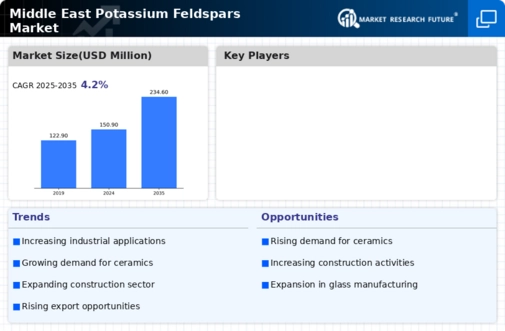Market Trends
Key Emerging Trends in the Middle East Potassium Feldspars Market
The Middle East K-feldspar market has witnessed notable trends in recent years, reflecting the region's evolving industrial landscape. Potassium feldspar, commonly known as K-feldspar, is a significant raw material in various industries, including ceramics, glass, and construction. The market trends in the Middle East are shaped by a combination of factors, influencing both the demand and supply dynamics.
One prominent trend in the Middle East K-feldspar market is the growing demand from the construction sector. As the region undergoes rapid urbanization and infrastructural development, there is an increased need for construction materials. K-feldspar, with its unique properties enhancing the strength and durability of concrete and ceramics, has become a preferred choice for construction applications. This trend is expected to persist as the construction industry continues to expand, driven by population growth and economic development in the Middle East.
Environmental sustainability is emerging as a key driver of market trends in the Middle East K-feldspar market. With a heightened focus on sustainable practices and green technologies, industries are seeking environmentally friendly raw materials. K-feldspar, being a naturally occurring mineral, aligns with these sustainability goals. Manufacturers are increasingly incorporating K-feldspar in their processes to meet both regulatory requirements and consumer expectations for eco-friendly products. This trend is likely to gain further momentum as environmental consciousness continues to grow in the region.
Geopolitical factors play a crucial role in shaping the Middle East K-feldspar market. The region is known for its rich mineral deposits, and geopolitical stability or instability can influence the exploration, extraction, and export of minerals. Changes in political landscapes, trade policies, or regional conflicts can impact the availability and pricing of K-feldspar in the market. Market participants need to closely monitor geopolitical developments to navigate potential challenges and capitalize on opportunities in the Middle East K-feldspar industry.
Technological advancements are driving innovation in the extraction and processing of K-feldspar in the Middle East. Improved mining and processing techniques contribute to increased efficiency and cost-effectiveness in production. These advancements not only benefit the industry by optimizing operations but also have downstream effects on factors such as product quality, pricing, and market competitiveness. The adoption of advanced technologies positions the Middle East K-feldspar market for sustainable growth and better integration with global supply chains.
Market dynamics are also influenced by the global economic landscape. Economic fluctuations, trade agreements, and currency valuations can impact the Middle East K-feldspar market. As the region actively participates in international trade, changes in global economic conditions can affect export and import activities related to K-feldspar. Market stakeholders need to stay informed about these external economic factors to make informed decisions and mitigate risks in the Middle East K-feldspar industry.



Leave a Comment